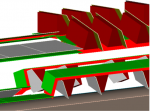In 2011, LAPP proposed a completely new concept of pixel detector, the most precise of the ATLAS detectors and the most central. The usual geometry in which the pixel modules are parallel to the axis of the beam has been revisited to propose tilted sensors, which minimize the amount of inert matter seen by the particles coming from the center of the detector where the collisions occur.
The prototype of an Alpine detector developed in the laboratory made it possible to demonstrate the mechanical feasibility, the thermal cooling capacity of the modules and to develop an appropriate design for the electrical services. The ATLAS group has also developed the computer tools needed to simulate the performance of this detector.
The inclined detector concept was chosen by the ATLAS collaboration in 2016 as the basis for the development of the future pixel detector which will be installed for HL-LHC data taking. LAPP team worked extensively to optimize the geometry of the final detector as well as the routing and design of the electrical services to minimize the amount of matter traversed by
the particles, a critical parameter for obtaining unparalleled performance at the HL-LHC. The ATLAS-Pixels group is in charge of developing and production of the electrical services for this new detector and will serve as one of the sites for the module integration and qualification.






















